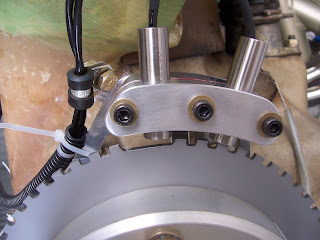These things had a positive effect:
- Temporarily replacing the 1/2" VRS sensor with an old 3/8" sensor. Ran a little better.
- Centering the sensor over the trigger teeth. Got another 200 RPM and noticeably smoother.
 Changing from a 6" trigger wheel to a 7-1/2" trigger wheel (photo attached), and sensor mounting brackets.
Changing from a 6" trigger wheel to a 7-1/2" trigger wheel (photo attached), and sensor mounting brackets.- Adjusting air gap from .030" to .055"

These things had a negative effect:
- Swapping the position of the primary and backup VRS sensors
- "Dressing up" the two tooth gap in the 7 1/2" trigger wheel. Actually, this was a bonehead move. I'm going to attempt repair it by having a pal fill it in with weld, then reduce it, so it pretty well matches the gap on the 6" wheel. The original configuration may help alleviate the phenomenon known as "phantom tooth".
- Swapping my standard trigger wheel with Lynn French's aluminum bowl and trigger wheel setup.
- When the engine is set at 6 deg. ATC, the primary sensor is directly over the first tooth in the gap. (photo attached shows the engine set exactly at TDC.).
- The air gap remains consistent all around the wheel, within a couple of thousandths.
- The engine starts easily and idles smoothly.
- When at about 700 RPM, the measured timing is around 38 deg. BTDC
- When running at full throttle (2,100 for now) the timing is about 25 deg. BTDC
- At high RPMs, the automotive style timing light flashes quite intermittently at the same time the engine starts missing, indicating, to me, that the signal is getting interference.
- Engine now runs pretty will up to about 1,900 - 2,000 RPM
- Borrow an oscilloscope to view the VRS sensor signal.
- Repair the trigger wheel.
- Inquire into getting a duplicate bowl, trigger wheel and mounting bracket ala Lynn French.
No comments:
Post a Comment